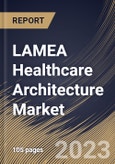Healthcare architecture plays a pivotal role in shaping the future of healthcare infrastructure and services. The design and building of healthcare facilities are going through a revolution as the healthcare sector continues to change due to technological innovations, changing demographics, and shifting patient expectations. This transformation is about aesthetics and creating spaces that enhance patient care, improve operational efficiency, and improve healthcare outcomes.
Additionally, hospitals and healthcare facilities often employ healthcare architecture for their design and construction. Architects work closely with healthcare providers to create environments conducive to healing, patient comfort, and efficient medical care. This includes considerations for layout, room design, infection control measures, and accessibility. Architectural principles are also employed in the development of clinics and outpatient centres. These facilities are designed to provide specialized care in a convenient and patient-friendly manner, often focusing on creating welcoming and non-intimidating spaces to reduce patient anxiety.
The UAE government is committed to providing top-notch healthcare services to its citizens and residents. Investments in healthcare architecture align with the government's vision to ensure access to world-class healthcare. Establishing new healthcare cities, hospitals, and specialized treatment centers reflects this commitment. The UAE strongly emphasizes adopting advanced medical technologies and digital healthcare solutions. These innovations require specialized infrastructure and facilities. Investment in healthcare architecture is crucial to accommodate cutting-edge technologies like robotic surgery, telemedicine, and AI-driven diagnostics. Therefore, the demand in the market in the LAMEA region is expected to grow substantially in the upcoming years.
The Brazil market dominated the LAMEA Healthcare Architecture Market, By Country in 2022, and would continue to be a dominant market till 2030; thereby, achieving a market value of $278.9 million by 2030. The Argentina market is showcasing a CAGR of 7.7% during (2023 - 2030). Additionally, The UAE market would register a CAGR of 6.8% during (2023 - 2030).
Based on Service Type, the market is segmented into New Construction, and Refurbishment. Based on Facility Type, the market is segmented into Hospitals, ASCs, Long Term Care Facilities & Nursing Homes, Academic Institutes, and Others. Based on countries, the market is segmented into Brazil, Argentina, UAE, Saudi Arabia, South Africa, Nigeria, and Rest of LAMEA.
The market research report covers the analysis of key stakeholders of the market. Key companies profiled in the report include HDR, Inc., Stantec, Inc., Perkins+Will (Dar Al-Handash Consultants), NBBJ L.P., Perkins Eastman, SmithGroup Companies, Inc., CannonDesign, Jacobs Engineering Group, Inc., HKS, Inc., and HOK Group, Inc.
Scope of the Study
Market Segments Covered in the Report:
By Service Type- New Construction
- Refurbishment
- Hospitals
- ASCs
- Long Term Care Facilities & Nursing Homes
- Academic Institutes
- Others
- Brazil
- Argentina
- UAE
- Saudi Arabia
- South Africa
- Nigeria
- Rest of LAMEA
Key Market Players
List of Companies Profiled in the Report:
- HDR, Inc.
- Stantec, Inc.
- Perkins+Will (Dar Al-Handash Consultants)
- NBBJ L.P.
- Perkins Eastman
- SmithGroup Companies, Inc.
- CannonDesign
- Jacobs Engineering Group, Inc.
- HKS, Inc.
- HOK Group, Inc.
Unique Offerings
- Exhaustive coverage
- The highest number of Market tables and figures
- Subscription-based model available
- Guaranteed best price
- Assured post sales research support with 10% customization free
Table of Contents
Companies Mentioned
- HDR, Inc.
- Stantec, Inc.
- Perkins+Will (Dar Al-Handash Consultants)
- NBBJ L.P.
- Perkins Eastman
- SmithGroup Companies, Inc.
- CannonDesign
- Jacobs Engineering Group, Inc.
- HKS, Inc.
- HOK Group, Inc.
Methodology

LOADING...








